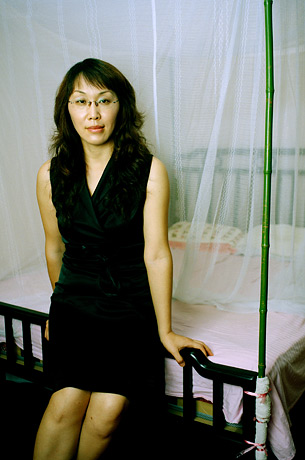
Liu Lichun, age 40, a breast cancer survivor, photographed at home in Shanghai, China.
(2 of 3)
Ethnicity as Destiny
Of all the things that can determine a woman's chances of surviving breast cancer, perhaps one of the most powerful is the simple matter of race. Most women in the U.S. are of European ancestry, and the majority of those who develop breast cancer are struck by a type that is partly stimulated by exposure to estrogen. This is one reason the disease usually hits in middle age, after 25 or so years of the monthly hormonal surges associated with ovulation and menstruation. Since the cancer relies on estrogen to grow, drugs like tamoxifen and Herceptin, which block hormone receptors on malignant cells, can help starve the disease.
But Asian women, as well as black women in the U.S. and Africa, are at higher risk of developing a more aggressive form of breast cancer known as estrogen-receptor negative, or ER-negative. That illness strikes an average of 10 years earlier than the other variety and is indifferent to drugs that block estrogen since it isn't fed by estrogen in the first place. Worse, research findings released in June 2006 showed that 40% of premenopausal African-American breast-cancer patients have an even more dangerous form of ER-negative cancer called the basal-like subtype, resistant not only to estrogen but also to progesterone, another hormone that can be blocked by treatment.
Genes can cause problems of their own — particularly for Asians. Fewer than 10% of American women with breast cancer have a form caused by an inherited mutation in their genes called BRCA1 and BRCA2, which makes them three to seven times as likely to fall ill. BRCA-related breast cancer is more apt to hit before age 50 and to recur in the second breast. In a 2002 study, University of Toronto doctors concluded that because of the relatively early age of Asian breast-cancer patients and because hereditary cancers disproportionately occur in young women, "a high proportion of breast cancer cases in the East may be attributable to BRCA1 and BRCA2." More worrisome, some studies show that more than 96% of BRCA mutation carriers have ER-negative cancers.
Merely detecting breast malignancies in the Asian population may present special difficulties. Asian women tend to have denser breast tissue than other women, and many studies show dense tissue is up to five times as likely to develop malignancies. What's more, such tissue can conceal the disease since both tumors and healthy tissue may show up white on a mammogram. Asian women even draw the short straw when it comes to treatment. Doses of conventional chemotherapy are determined partly by a patient's height and weight, but mounting evidence suggests that certain ethnic groups absorb the chemicals differently. Researchers in Singapore have shown that Caucasian patients may require higher doses per pound of body weight than non-Caucasians. Since most dosing regimens are calibrated to the Western body, some doctors in Singapore report having to adjust quantities in up to 30% of their patients to avoid adverse side effects. "Local scientists must do their own research and find their own regimens," says Dr. Richard Love, scientific director for the Wisconsin-based International Breast Cancer Research Foundation.
Western Ways, Western Woes
If the spread of U.S. and European lifestyles is indeed contributing to the breast-cancer boom, the first and worst of all those new habits is almost surely diet. In a study released in July, scientists traced the eating habits of 3,000 Chinese women, ranging in age from 25 to 64. Half of the group ate a "meat sweet" diet of Western cuisine, rich in red meat, shrimp, fish, candy, desserts, bread and milk. The others stuck to more traditional Asian fare of tofu, vegetables, sprouts, beans, fish and soy milk. Postmenopausal women in the meat-sweet group showed a 60% greater risk of developing the most common kind of breast cancer.
While these results aren't definitive, researchers in Saudi Arabia and along Europe's Mediterranean coast have found similar patterns, as customary low-fat foods are abandoned. "We blindly accepted that the Western way of life was better," says Dr. Xu Guangwei, head of the Beijing-based China Anti-Cancer Association.
Western reproductive habits are also coming under scrutiny. As more women in newly industrializing nations join the workforce, they are limiting the number of children they are having. Research shows that women who give birth to fewer than two children have a higher risk of developing breast cancer than women who have larger broods. Part of the reason is probably that pregnancy and nursing provide the body with a sort of estrogen holiday, as the menstrual cycle is shut down for at least nine months and often a lot longer.
Pregnancy and lactation may also change breast tissue by building antibodies that help prevent cells from becoming cancerous. The fewer pregnancies a woman has, the less this modification occurs. "[In India] what was protecting women in the past was that they had many children," says Dr. Vinod Raina, an oncologist in Delhi. Other researchers go even further, venturing to put a number on that claim. "Reproductive changes explain about 30% to 40% of breast-cancer threat," says Dr. Wei Zheng, an epidemiologist at Vanderbilt University in Nashville.
Then, too, there's lack of exercise — a growing problem in the Western world. People who work on farms and in factories may get a workout all day long. But the more a globalizing world shifts from fields to offices, the less moving we do. Research released in February by the University of Southern California showed that among a sample group of 110,599 people, women who engaged in strenuous activity five hours a week had, over the long term, a 20% lower risk of invasive breast cancer, particularly ER-negative tumors. Doctors aren't certain about the precise mechanism at work, but the leaner body mass an active woman is likely to have and the healthier diet she is likely to follow can't hurt.